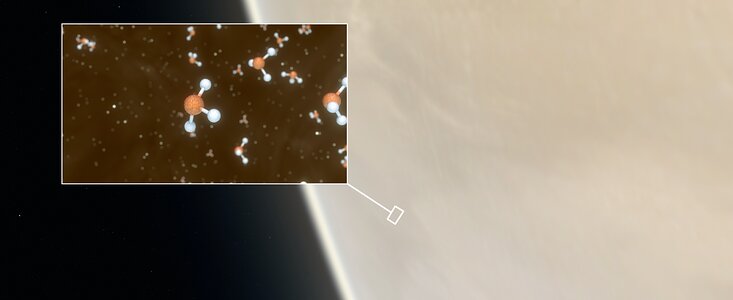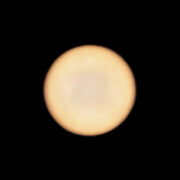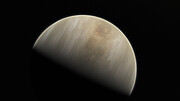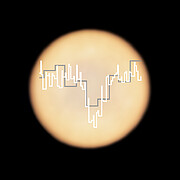Persbericht
Mogelijke indicator van leven ontdekt op Venus
14 september 2020

Een internationaal team van astronomen heeft vandaag de ontdekking bekendgemaakt van een zeldzaam molecuul – fosfine – in de wolken van Venus. Op aarde wordt dit gas alleen geproduceerd door de industrie of door micro-organismen die in zuurstofvrije milieus gedijen. Astronomen speculeren al tientallen jaren over de mogelijkheid dat hoge wolken op Venus een broedplaats kunnen zijn van micro-organismen die het snikhete planeetoppervlak vermijden, maar wel bestand moeten zijn tegen een zeer hoge zuurgraad. De detectie van fosfine zou erop kunnen wijzen dat dit buitenaardse ‘luchtleven’ echt bestaat.
‘Toen we de eerste aanwijzingen voor fosfine in het spectrum van Venus aantroffen, was dat een schok!’, zegt teamleider Jane Greaves van Cardiff University (VK), die de signatuur van fosfine als eerste opmerkte in waarnemingen van de James Clerk Maxwell Telescope (JCMT), die wordt beheerd door de East Asian Observatory op Hawaï. Om deze ontdekking te bevestigen moesten de 45 antennes van de Atacama Large Millimeter/submillimeter Array (ALMA) in Chili, een gevoeligere telescoop waarin de Europese Zuidelijke Sterrenwacht (ESO) partner is, worden ingezet. Beide faciliteiten namen Venus waar op een golflengte van ongeveer 1 millimeter – een type straling dat niet waarneembaar is met het menselijk oog. Alleen speciale telescopen die op grote hoogte zijn gestationeerd kunnen deze straling goed detecteren.
Het internationale team, met onderzoekers uit het VK, de VS en Japan, schat dat fosfine slechts in kleine concentraties in de wolken van Venus voorkomt: ongeveer twintig op elke miljard moleculen. In vervolg op hun waarnemingen hebben de astronomen berekeningen gedaan om te onderzoeken of deze hoeveelheden afkomstig zouden kunnen zijn van natuurlijke niet-biologische processen op de planeet. Daarbij is onder meer gedacht aan de inwerking van zonlicht, mineralen die zijn opgestoven vanaf het oppervlak, vulkanische activiteit en bliksem, maar deze processen zouden fosfine bij lange na niet in de waargenomen hoeveelheden kunnen produceren. De niet-biologische bronnen zouden hooguit een tienduizendste daarvan voor hun rekening kunnen nemen.
Om de gedetecteerde hoeveelheid fosfine (dat uit waterstof en fosfor bestaat) op Venus te kunnen produceren, zouden aardse organismen volgens het team op ongeveer tien procent van hun maximale capaciteit moeten werken. Van aardse bacteriën is bekend dat ze fosfine maken: ze nemen fosfaten op uit mineralen of biologisch materiaal, voegen waterstof toe, en stoten ten slotte fosfine uit. Eventuele organismen op Venus zullen waarschijnlijk heel anders zijn dan hun aardse verwanten, maar ook zij zouden de bron van de atmosferische fosfine kunnen zijn.
Hoewel de ontdekking van fosfine in de wolken van Venus als een verrassing kwam, hebben de onderzoekers vertrouwen in hun detectie. ‘Tot onze grote opluchting waren de omstandigheden voor de vervolgwaarnemingen met ALMA goed, en stond Venus onder een gunstige hoek ten opzichte van de aarde. De verwerking van de gegevens was echter lastig, omdat ALMA doorgaans niet naar subtiele effecten in zeer heldere objecten zoals Venus kijkt’, zegt teamlid Anita Richards van het UK ALMA Regional Centre en de Universiteit van Manchester. ‘Uiteindelijk ontdekten we dat beide sterrenwachten hetzelfde hadden gezien: de zwakke absorptie op de juiste golflengte om fosfine-gas te kunnen zijn, waarbij de moleculen door lagere, warmere wolken worden verlicht’, voegt Greaves, hoofdauteur van het vandaag in Nature Astronomy gepubliceerde onderzoek, daaraan toe.
Een ander teamlid, Clara Sousa Silva van het Massachusetts Institute of Technology in de VS, heeft onderzocht in hoeverre fosfine kan worden gebruikt als ‘biosignatuur’-gas van leven op planeten rond andere sterren. Bij gewone chemische processen komt namelijk maar heel weinig van dit gas vrij. Ze zegt: ‘De ontdekking van fosfine op Venus was een onverwachte meevaller! Ze roept wel veel vragen op, zoals hoe eventuele organismen daar zouden kunnen overleven. Op aarde zijn micro-organismen bestand tegen ongeveer vijf procent zuur in hun milieu, maar de wolken op Venus bestaan vrijwel geheel uit zuur.’
Het team denkt dat hun ontdekking hout snijdt, omdat vele alternatieve manieren om fosfine te maken kunnen worden uitgesloten. Tegelijkertijd geven de astronomen toe dat het aantonen van de aanwezigheid van ‘leven’ nog veel onderzoek zal vergen. Hoewel de hoge wolken op Venus aangename temperaturen van rond de 30 graden Celsius hebben, zijn ze ongelooflijk zuur. Ze bestaan voor ongeveer 90 procent uit zwavelzuur, wat nogal problematisch kan zijn voor eventueel aanwezige micro-organismen.
ESO-astronoom en Europees ALMA programma-manager Leonardo Testi, die niet bij het nieuwe onderzoek betrokken was, zegt: ‘De niet-biologische productie van fosfine op Venus is in strijd met onze huidige kennis van de fosfine-chemie in de atmosferen van rotsachtige planeten. De bevestiging van leven in de Venus-atmosfeer zou een grote doorbraak betekenen voor de astrobiologie. Het is dus van cruciaal belang om dit spannende resultaat een vervolg te geven in de vorm van theoretisch en observationeel onderzoek, om de mogelijkheid uit te sluiten dat fosfine op rotsachtige planeten ook een andere chemische oorsprong kan hebben dan op aarde.’
Verdere waarnemingen van Venus en van rotsachtige planeten buiten ons zonnestelsel, bijvoorbeeld met ESO’s toekomstige Extremely Large Telescope, kan aanwijzingen opleveren over het ontstaan van fosfine en bijdragen aan de zoektocht naar tekenen van leven buiten de aarde.
Meer informatie
De resultaten van dit onderzoek zijn gepresenteerd in het artikel ‘Phosphine Gas in the Cloud Decks of Venus’ dat in Nature Astronomy verschijnt.
Het onderzoeksteam bestaat uit Jane S. Greaves (School of Physics & Astronomy, Cardiff University, VK [Cardiff]), Anita M. S. Richards (Jodrell Bank Centre for Astrophysics, The University of Manchester, VK), William Bains (Department of Earth, Atmospheric, and Planetary Sciences, Massachusetts Institute of Technology, VS [MIT]), Paul Rimmer (Department of Earth Sciences and Cavendish Astrophysics, University of Cambridge en MRC Laboratory of Molecular Biology, Cambridge, UVK), Hideo Sagawa (Department of Astrophysics and Atmospheric Science, Kyoto Sangyo University, Japan), David L. Clements (Department of Physics, Imperial College London, VK [Imperial]), Sara Seager (MIT), Janusz J. Petkowski (MIT), Clara Sousa-Silva (MIT), Sukrit Ranjan (MIT), Emily Drabek-Maunder (Cardiff en Royal Observatory Greenwich, London, VK), Helen J. Fraser (School of Physical Sciences, The Open University, Milton Keynes, VK), Annabel Cartwright (Cardiff), Ingo Mueller-Wodarg (Imperial), Zhuchang Zhan (MIT), Per Friberg (EAO/JCMT), Iain Coulson (EAO/JCMT), E’lisa Lee (EAO/JCMT) en Jim Hoge (EAO/JCMT).
Een begeleidend artikel door enkele van de teamleden, getiteld ‘The Venusian Lower Atmosphere Haze as a Depot for Desiccated Microbial Life: A Proposed Life Cycle for Persistence of the Venusian Aerial Biosphere’, is in augustus 2020 gepubliceerd in Astrobiology. De resultaten van een ander gerelateerd onderzoek door enkele van dezelfde auteurs – ‘Phosphine as a Biosignature Gas in Exoplanet Atmospheres’ – zijn in januari 2020 gepubliceerd in Astrobiology.
ESO is de belangrijkste intergouvernementele astronomische organisatie in Europa en verreweg de meest productieve sterrenwacht ter wereld. Zij wordt ondersteund door zestien lidstaten: België, Denemarken, Duitsland, Finland, Frankrijk, Ierland, Italië, Nederland, Oostenrijk, Polen, Portugal, Spanje, Tsjechië, het Verenigd Koninkrijk, Zweden en Zwitserland, en door gastland Chili, met Australië als strategische partner. ESO voert een ambitieus programma uit, gericht op het ontwerpen, bouwen en beheren van grote sterrenwachten die astronomen in staat stellen om belangrijke wetenschappelijke ontdekkingen te doen. Ook speelt ESO een leidende rol bij het bevorderen en organiseren van samenwerking op astronomisch gebied. ESO beheert drie waarnemingslocaties van wereldklasse in Chili: La Silla, Paranal en Chajnantor. Op Paranal staan ESO’s Very Large Telescope (VLT) en haar toonaangevende Very Large Telescope Interferometer, evenals twee surveytelescopen – VISTA, die in het infrarood werkt, en de op zichtbare golflengten opererende VLT Survey Telescope. Ook op Paranal zal ESO onderkomen bieden aan en het beheer voeren over de Cherenkov Telescope Array South, ’s werelds grootste en meest gevoelige observatorium van gammastraling. ESO speelt tevens een belangrijke partnerrol bij twee faciliteiten op Chajnantor, APEX en ALMA, het grootste astronomische project van dit moment. En op Cerro Armazones, nabij Paranal, bouwt ESO de 39-meter Extremely Large Telescope, de ELT, die ‘het grootste oog op de hemel’ ter wereld zal worden.
De Atacama Large Millimeter/submillimeter Array (ALMA), een internationale astronomische faciliteit, is een samenwerkingsverband van ESO, de Amerikaanse National Science Foundation (NSF) en de National Institutes of Natural Sciences (NINS) van Japan, in samenwerking met de Republiek Chili. ALMA wordt gefinancierd door ESO (namens haar lidstaten), door de NSF in samenwerking met de National Research Council of Canada (NRC) en de National Science Council of Taiwan (NSC), en door NINS in samenwerking met de Academia Sinica (AS) in Taiwan en het Korea Astronomy and Space Science Institute (KASI). De bouw en het beheer van ALMA worden geleid door ESO (namens haar lidstaten); door het National Radio Astronomy Observatory (NRAO), dat namens Noord-Amerika wordt bestuurd door de Associated Universities, Inc. (AUI), en namens Oost-Azië door het National Astronomical Observatory of Japan (NAOJ). De overkoepelende leiding en het toezicht op bouw, ingebruikname en beheer van ALMA is in handen van het Joint ALMA Observatory (JAO).
Met een diameter van 15 meter is de James Clerk Maxwell Telescope (JCMT) de grootste enkelvoudige schotelantenne voor astronomisch onderzoek ter wereld die speciaal is ontworpen om in het submillimetergebied van het elektromagnetische spectrum te opereren. De JCMT wordt gebruikt voor onderzoek van ons zonnestelsel, interstellair en circumstellair stof en gas, geëvolueerde sterren en verre sterrenstelsel. Hij staat opgesteld in het wetenschappelijke reservaat op Maunakea, Hawaï, op een hoogte van 4092 meter. De JCMT wordt beheerd door de East Asian Observatory, uit naam van NAOJ, ASIAA, KASI, CAMS en het National Key R&D Program van China. Aanvullende financiële ondersteuning wordt verschaft door de STFC en deelnemende universiteiten het VK en Canada.
Links
- Onderzoeksartikel
- Foto’s van ALMA
- Foto’s van de JCMT
- Gerelateerd eerder ESO-persbericht: Astronomers Reveal Interstellar Thread of One of Life’s Building Blocks: ALMA and Rosetta map the journey of phosphorus
- Gerelateerd eerder persbericht van de Royal Astronomical Society: Paucity of phosphorus hints at precarious path for extraterrestrial life
- Voor wetenschappers: heb je een verhaal? Promoot je onderzoek
Contact
Jane Greaves (study author)
Cardiff University
Cardiff, UK
E-mail: GreavesJ1@cardiff.ac.uk
Anita Richards (study author)
UK ALMA Regional Centre and University of Manchester
Manchester, UK
E-mail: a.m.s.richards@manchester.ac.uk
Clara Sousa Silva (study author)
Massachusetts Institute of Technology
Cambridge, USA
Tel: +1 617 253 6283
E-mail: cssilva@mit.edu
Leonardo Testi (contact for independent comment on the study)
European Southern Observatory
Garching bei München, Germany
Tel: +49 89 3200 6541
E-mail: ltesti@eso.org
Dave Clements (study author)
Imperial College
London, UK
E-mail: d.clements@imperial.ac.uk
Paul Rimmer (study author)
University of Cambridge
Cambridge, UK
E-mail: pbr27@cam.ac.uk
William Bains (study author)
Massachusetts Institute of Technology
Cambridge, USA
E-mail: bains@mit.edu
Bárbara Ferreira
ESO Public Information Officer
Garching bei München, Germany
Tel: +49 89 3200 6670
Mobiel: +49 151 241 664 00
E-mail: pio@eso.org
Marieke Baan (Perscontact Nederland)
ESO Science Outreach Network
en NOVA Informatie Centrum
Tel: +31(0)20-5257480
E-mail: eson-netherlands@eso.org
Over dit bericht
| Persberichten nr.: | eso2015nl |
| Naam: | Venus |
| Type: | Solar System : Planet : Feature : Atmosphere |
| Facility: | Atacama Large Millimeter/submillimeter Array |
| Science data: | 2021NatAs...5..655G |
Our use of Cookies
We use cookies that are essential for accessing our websites and using our services. We also use cookies to analyse, measure and improve our websites’ performance, to enable content sharing via social media and to display media content hosted on third-party platforms.
ESO Cookies Policy
The European Organisation for Astronomical Research in the Southern Hemisphere (ESO) is the pre-eminent intergovernmental science and technology organisation in astronomy. It carries out an ambitious programme focused on the design, construction and operation of powerful ground-based observing facilities for astronomy.
This Cookies Policy is intended to provide clarity by outlining the cookies used on the ESO public websites, their functions, the options you have for controlling them, and the ways you can contact us for additional details.
What are cookies?
Cookies are small pieces of data stored on your device by websites you visit. They serve various purposes, such as remembering login credentials and preferences and enhance your browsing experience.
Categories of cookies we use
Essential cookies (always active): These cookies are strictly necessary for the proper functioning of our website. Without these cookies, the website cannot operate correctly, and certain services, such as logging in or accessing secure areas, may not be available; because they are essential for the website’s operation, they cannot be disabled.
Functional Cookies: These cookies enhance your browsing experience by enabling additional features and personalization, such as remembering your preferences and settings. While not strictly necessary for the website to function, they improve usability and convenience; these cookies are only placed if you provide your consent.
Analytics cookies: These cookies collect information about how visitors interact with our website, such as which pages are visited most often and how users navigate the site. This data helps us improve website performance, optimize content, and enhance the user experience; these cookies are only placed if you provide your consent. We use the following analytics cookies.
Matomo Cookies:
This website uses Matomo (formerly Piwik), an open source software which enables the statistical analysis of website visits. Matomo uses cookies (text files) which are saved on your computer and which allow us to analyze how you use our website. The website user information generated by the cookies will only be saved on the servers of our IT Department. We use this information to analyze www.eso.org visits and to prepare reports on website activities. These data will not be disclosed to third parties.
On behalf of ESO, Matomo will use this information for the purpose of evaluating your use of the website, compiling reports on website activity and providing other services relating to website activity and internet usage.
Matomo cookies settings:
Additional Third-party cookies on ESO websites: some of our pages display content from external providers, e.g. YouTube.
Such third-party services are outside of ESO control and may, at any time, change their terms of service, use of cookies, etc.
YouTube: Some videos on the ESO website are embedded from ESO’s official YouTube channel. We have enabled YouTube’s privacy-enhanced mode, meaning that no cookies are set unless the user actively clicks on the video to play it. Additionally, in this mode, YouTube does not store any personally identifiable cookie data for embedded video playbacks. For more details, please refer to YouTube’s embedding videos information page.
Cookies can also be classified based on the following elements.
Regarding the domain, there are:
- First-party cookies, set by the website you are currently visiting. They are stored by the same domain that you are browsing and are used to enhance your experience on that site;
- Third-party cookies, set by a domain other than the one you are currently visiting.
As for their duration, cookies can be:
- Browser-session cookies, which are deleted when the user closes the browser;
- Stored cookies, which stay on the user's device for a predetermined period of time.
How to manage cookies
Cookie settings: You can modify your cookie choices for the ESO webpages at any time by clicking on the link Cookie settings at the bottom of any page.
In your browser: If you wish to delete cookies or instruct your browser to delete or block cookies by default, please visit the help pages of your browser:
Please be aware that if you delete or decline cookies, certain functionalities of our website may be not be available and your browsing experience may be affected.
You can set most browsers to prevent any cookies being placed on your device, but you may then have to manually adjust some preferences every time you visit a site/page. And some services and functionalities may not work properly at all (e.g. profile logging-in, shop check out).
Updates to the ESO Cookies Policy
The ESO Cookies Policy may be subject to future updates, which will be made available on this page.
Additional information
For any queries related to cookies, please contact: pdprATesoDOTorg.
As ESO public webpages are managed by our Department of Communication, your questions will be dealt with the support of the said Department.








